Airmass Analysis of Size-Resolved Black Carbon Particles Observed in the Arctic Based on Cluster Analysis
Abstract
:1. Introduction
2. Materials and Methods
2.1. Zeppelin Data
2.2. BC Number Size Distribution
2.3. Back-Trajectories with HYSPLIT
2.4. Trajectory Source Mapping
3. Results
4. Discussion
5. Summary & Conclusions
- Subgroup 1 is associated with transport from a sector including Western Europe/North Atlantic. Transport in this western sector is typically exposed to more precipitation which may act as an effective sink for aerosol particles. More frequent cloud processing may also change the mixing state/shape and density of BC containing aerosol particles due to both physical and chemical effects associated with repeated cycles of activation/evaporation.
- Airmass source areas for Subgroup 2 are biased towards Eurasia. The source attribution function shows that peak values in BC observed at the Zeppelin Observatory are associated with transport from Northern Eurasia/Russia, and large differences in source attribution function are present comparing Eastern and Western Hemispheres. The eBC associated with Subgroup 2 is not affected by precipitation on its transport path. This could be a reason for higher eBC concentration compared to Subgroup 1.
- We have introduced the normalised effective potential source contribution (S) function that represents the product of the transport probability function and the source attribution function. This quantity, which reflects the apparent importance of different source regions contributing to the bulk of BC observations, is markedly different comparing Subgroups 1 and 2. For Subgroup 2, S is dominated by Russia, covering the bulk of northern Eurasia from the Urals eastward. Subgroup 1 instead has the largest contribution of BC from the Western Hemisphere, and comparably less influence from Eastern Eurasia. The potential source regions for the second subgroup co-locate with known biomass-burning areas.
Author Contributions
Funding
Institutional Review Board Statement
Informed Consent Statement
Data Availability Statement
Acknowledgments
Conflicts of Interest
Abbreviations
| BC | Black Carbon |
| eBC | equivalent Black Carbon |
| PNSD | Particle Number Size Distribution |
| PSAP | Particle Soot Absorption Photometer |
| DMPS | Differential Mobility Particles Sizer |
| RH | Relative Humidity |
| HYSPLIT | Hybrid Single Particle Lagrangian Integrated Trajectory |
| NAO | North Atlantic Oscillation |
| SCAN | Scandinavian Pattern |
Appendix A. Microphysical Properties
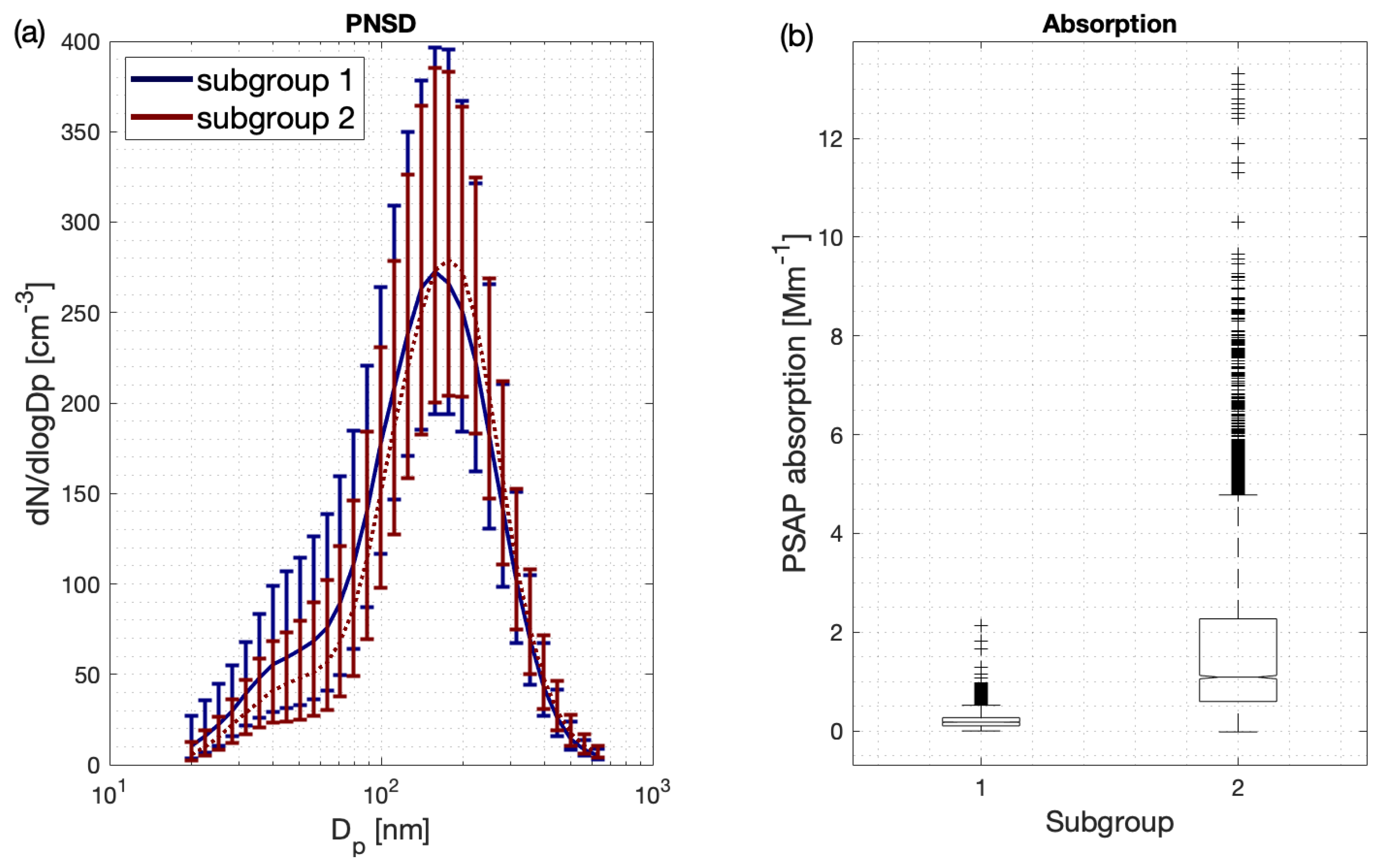
Appendix B. Chemical Composition
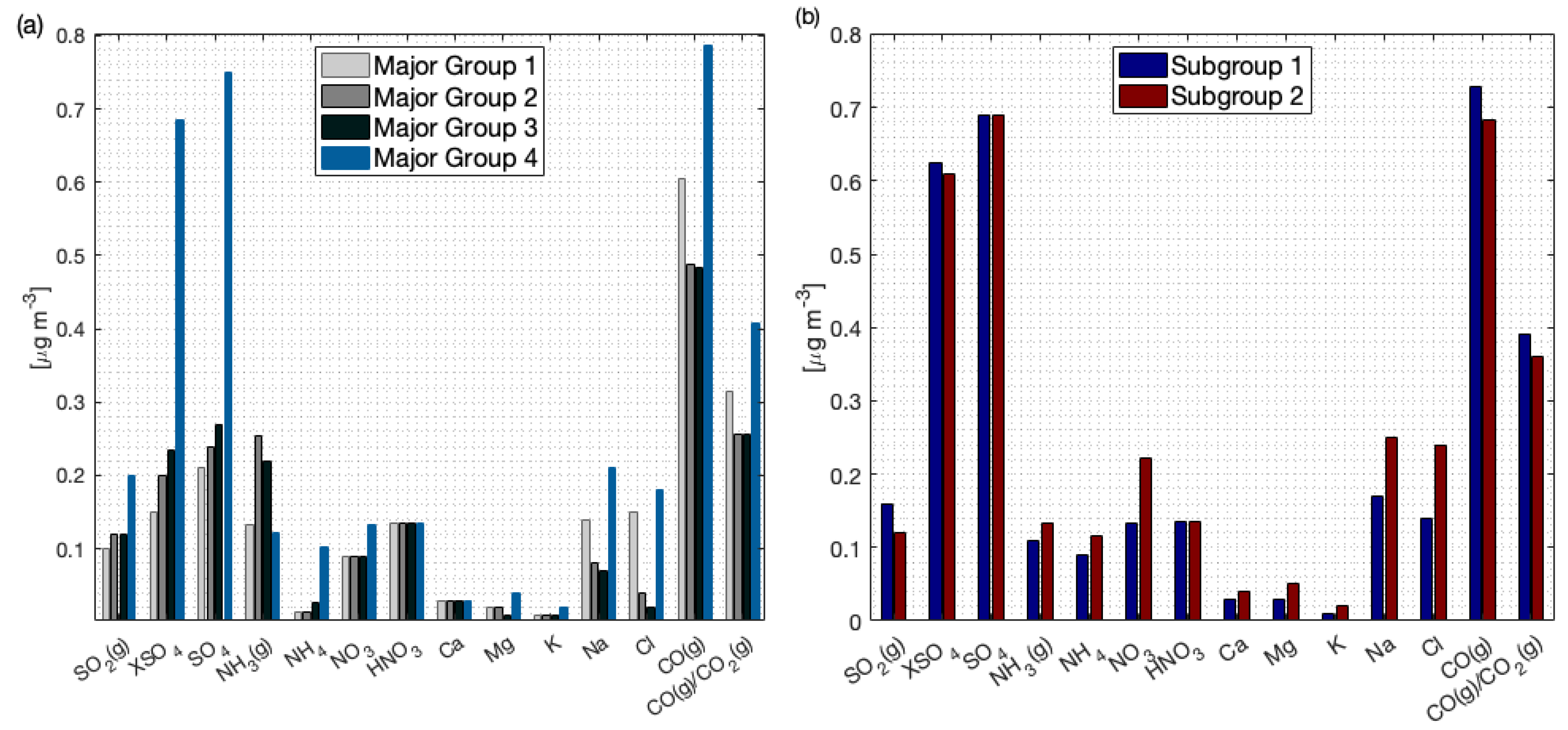
Appendix C. Transport Probability Function

| Cluster Group | Washout | Nucleation | Intermediate | Polluted | ||
|---|---|---|---|---|---|---|
| Total | Subgroups A & B | |||||
| # observations | 14,901 | 1974 | 5917 | 11,447 | 5639 | 5809 |
| # ensembles | 14,729 | 1974 | 5915 | 11,332 | 5610 | 5722 |
Appendix D. Median Observed Particle Size Distribution
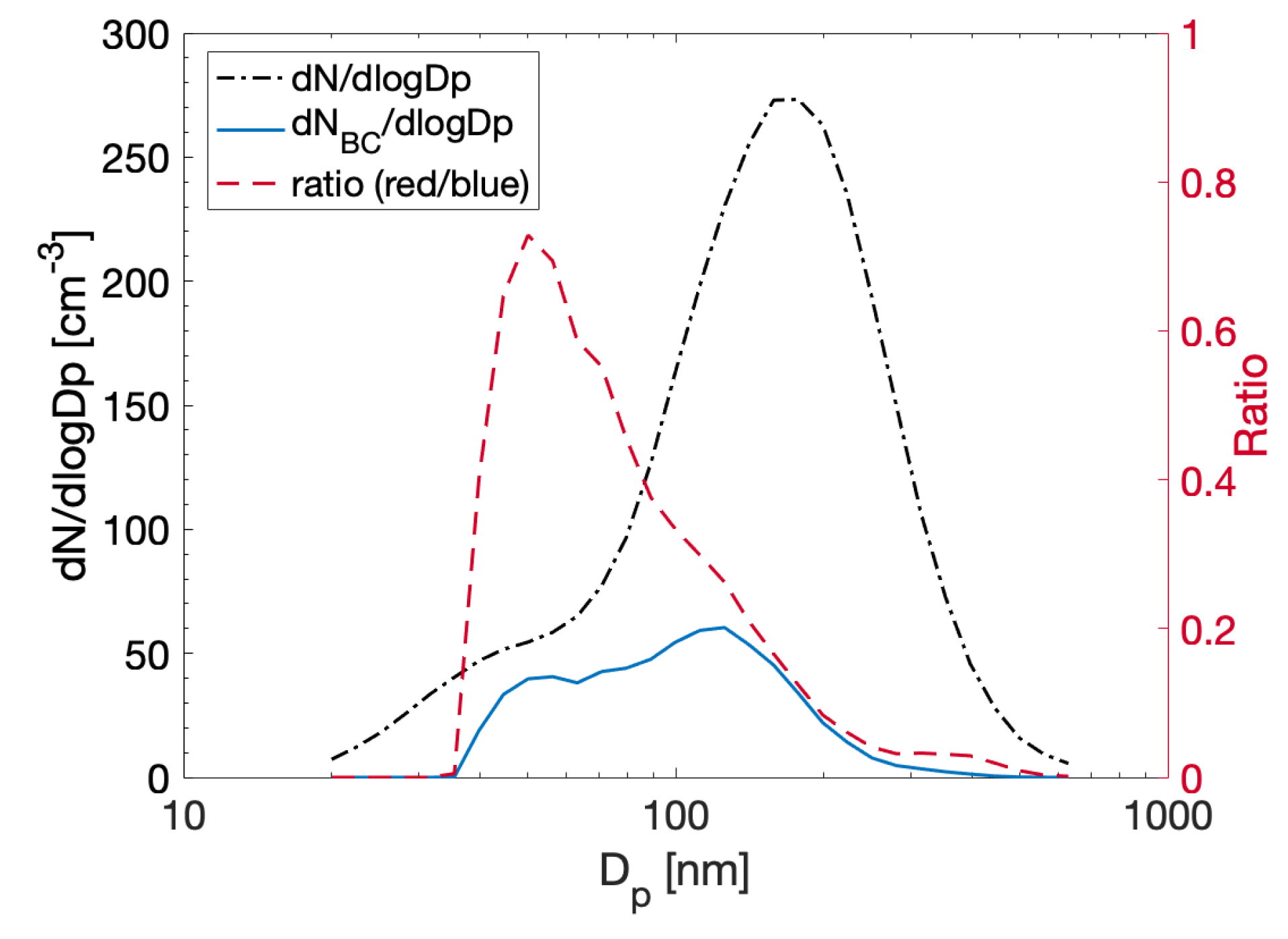
Appendix E. GFED4 Burnt Area
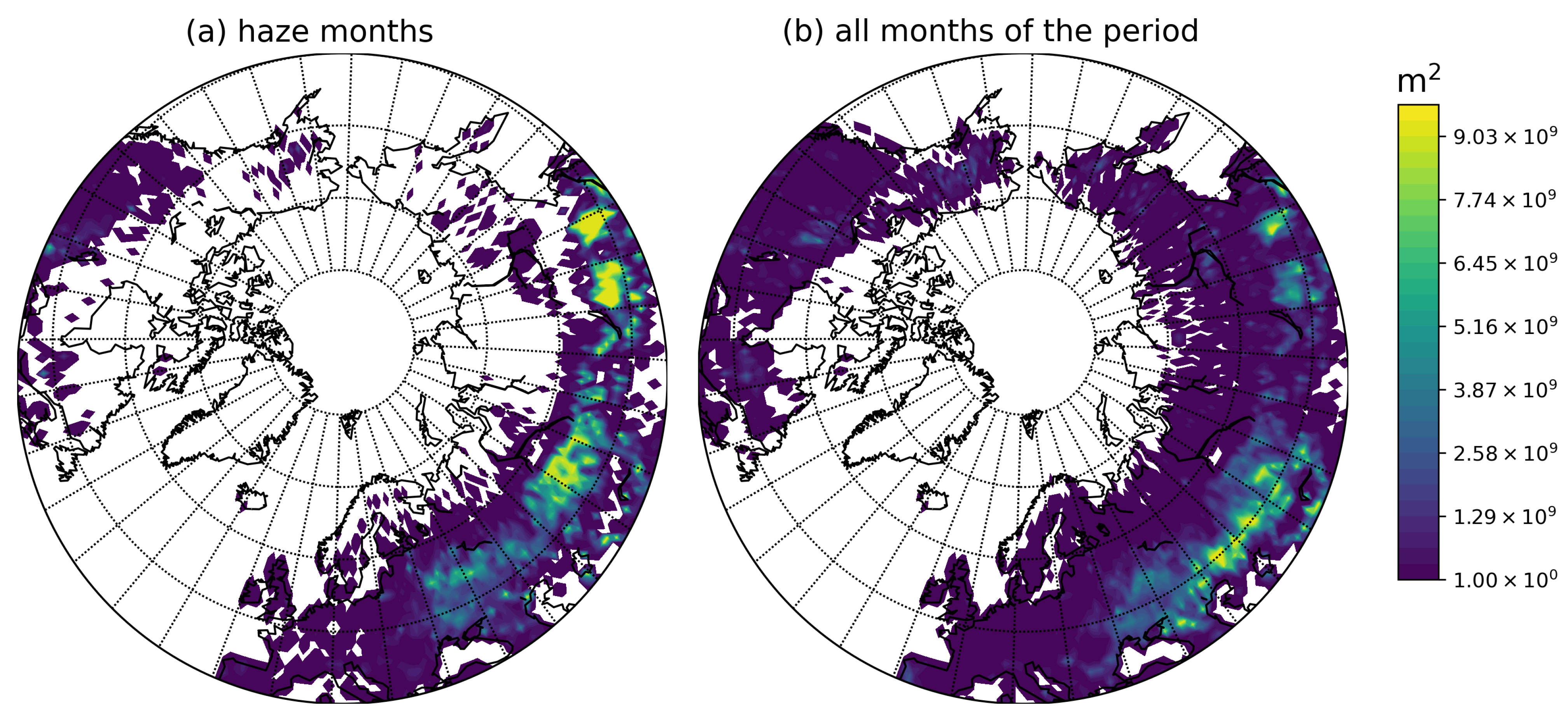
References
- Petzold, A.; Kramer, H.; Schönlinner, M. Continuous measurement of atmospheric black carbon using a multi-angle absorption photometer. Environ. Sci. Pollut. Res. 2002, 4, 78–82. [Google Scholar] [CrossRef]
- IPCC. Climate Change 2014: The Physical Science Basis. Contribution of Working Group I to the Fifth Assessment Report of the Intergovernmental Panel on Climate Change; Cambridge University: Cambridge, UK, 2014; p. 1535. [Google Scholar] [CrossRef] [Green Version]
- Yang, Y.; Smith, S.J.; Wang, H.; Mills, C.M.; Rasch, P.J. Variability, timescales, and nonlinearity in climate responses to black carbon emissions. Atmos. Chem. Phys. 2019, 19, 2405–2420. [Google Scholar] [CrossRef] [Green Version]
- Serreze, M.C.; Barry, R.G. Processes and impacts of Arctic amplification: A research synthesis. Glob. Planet. Chang. 2011, 77, 85–96. [Google Scholar] [CrossRef]
- Sand, M.; Berntsen, T.K.; Seland, Ø.; Kristjánsson, J.E. Arctic surface temperature change to emissions of black carbon within Arctic or midlatitudes. J. Geophys. Res. Atmos. 2013, 118, 7788–7798. [Google Scholar] [CrossRef]
- AMAP. Arctic Monitoring and Assessment Programme, AMAP Assessment 2015: Black Carbon and Ozone as Arctic Climate Forcers; AMAP: Oslo, Norway, 2015. [Google Scholar]
- Bond, T.C.; Doherty, S.J.; Fahey, D.W.; Forster, P.M.; Berntsen, T.; DeAngelo, B.J.; Flanner, M.G.; Ghan, S.; Kärcher, B.; Koch, D.; et al. Bounding the role of black carbon in the climate system: A scientific assessment. J. Geophys. Res. Atmos. 2013, 118, 5380–5552. [Google Scholar] [CrossRef]
- Novakov, T.; Rosen, H. The black carbon story: Early history and new perspectives. Ambio 2013, 42, 840–851. [Google Scholar] [CrossRef] [PubMed] [Green Version]
- Cai, S.; Hsu, P.C.; Liu, F. Changes in polar amplification in response to increasing warming in CMIP6. Atmos. Ocean. Sci. Lett. 2021, 14, 100043. [Google Scholar] [CrossRef]
- Cohen, J.; Screen, J.A.; Furtado, J.C.; Barlow, M.; Whittleston, D.; Coumou, D.; Francis, J.; Dethloff, K.; Entekhabi, D.; Overland, J.; et al. Recent Arctic amplification and extreme mid-latitude weather. Nat. Geosci. 2014, 7, 627–637. [Google Scholar] [CrossRef] [Green Version]
- Wendisch, M.; Brückner, M.; Burrows, J.; Crewell, S.; Dethloff, K.; Ebell, K.; Lüpkes, C.; Macke, A.; Notholt, J.; Quaas, J.; et al. ArctiC amplification: Climate relevant atmospheric and SurfaCe processes, and feedback mechanisms:(AC) 3. Eos. Trans. Am. Geophys. Union 2017, 98, 1029. [Google Scholar]
- Khan, S.A.; Aschwanden, A.; Bjørk, A.A.; Wahr, J.; Kjeldsen, K.K.; Kjaer, K.H. Greenland ice sheet mass balance: A review. Rep. Prog. Phys. 2015, 78, 046801. [Google Scholar] [CrossRef]
- Stohl, A.; Klimont, Z.; Eckhardt, S.; Kupiainen, K.; Shevchenko, V.P.; Kopeikin, V.; Novigatsky, A. Black carbon in the Arctic: The underestimated role of gas flaring and residential combustion emissions. Atmos. Chem. Phys. 2013, 13, 8833–8855. [Google Scholar] [CrossRef] [Green Version]
- Schmale, J.; Arnold, S.; Law, K.S.; Thorp, T.; Anenberg, S.; Simpson, W.; Mao, J.; Pratt, K. Local Arctic air pollution: A neglected but serious problem. Earths Future 2018, 6, 1385–1412. [Google Scholar] [CrossRef]
- Stohl, A. Characteristics of atmospheric transport into the Arctic troposphere. J. Geophys. Res. Atmos. 2006, 111. [Google Scholar] [CrossRef]
- Sand, M.; Berntsen, T.K.; von Salzen, K.; Flanner, M.G.; Langner, J.; Victor, D.G. Response of Arctic temperature to changes in emissions of short-lived climate forcers. Nat. Clim. Chang. 2016, 6, 286–289. [Google Scholar] [CrossRef]
- Korhonen, H.; Carslaw, K.S.; Spracklen, D.V.; Ridley, D.A.; Ström, J. A global model study of processes controlling aerosol size distributions in the Arctic spring and summer. J. Geophys. Res. Atmos 2008, 113. [Google Scholar] [CrossRef] [Green Version]
- Petzold, A.; Ogren, J.A.; Fiebig, M.; Laj, P.; Li, S.M.; Baltensperger, U.; Holzer-Popp, T.; Kinne, S.; Pappalardo, G.; Sugimoto, N.; et al. Recommendations for reporting “black carbon” measurements. Atmos. Chem. Phys. 2013, 13, 8365–8379. [Google Scholar] [CrossRef] [Green Version]
- Tunved, P.; Cremer, R.; Zieger, P.; Ström, J. Using correlations between observed equivalent black carbon and aerosol size distribution to derive size resolved BC mass concentration: A method applied on long-term observations performed at Zeppelin station, Ny-Ålesund, Svalbard. Tellus B Chem. Phys. Meteorol. 2021, 73, 1–17. [Google Scholar] [CrossRef]
- Stohl, A.; Berg, T.; Burkhart, J.; Fjæraa, A.; Forster, C.; Herber, A.; Hov, Ø.; Lunder, C.; McMillan, W.; Oltmans, S.; et al. Arctic smoke–record high air pollution levels in the European Arctic due to agricultural fires in Eastern Europe in spring 2006. Atmos. Chem. Phys. 2007, 7, 511–534. [Google Scholar] [CrossRef] [Green Version]
- Tunved, P.; Ström, J. On the seasonal variation in observed size distributions in northern Europe and their changes with decreasing anthropogenic emissions in Europe: Climatology and trend analysis based on 17 years of data from Aspvreten, Sweden. Atmos. Chem. Phys. 2019, 19, 14849–14873. [Google Scholar] [CrossRef] [Green Version]
- Stein, A.; Draxler, R.R.; Rolph, G.D.; Stunder, B.J.; Cohen, M.; Ngan, F. NOAA’s HYSPLIT atmospheric transport and dispersion modeling system. Bull. Am. Meteo. Soc. 2015, 96, 2059–2077. [Google Scholar] [CrossRef]
- Eleftheriadis, K.; Vratolis, S.; Nyeki, S. Aerosol black carbon in the European Arctic: Measurements at Zeppelin station, Ny-Ålesund, Svalbard from 1998–2007. Geophys. Res. Lett. 2009, 36. [Google Scholar] [CrossRef] [Green Version]
- Hakuba, M.Z.; Folini, D.; Wild, M.; Schär, C. Impact of Greenland’s topographic height on precipitation and snow accumulation in idealized simulations. J. Geophys. Res. Atmos. 2012, 117. [Google Scholar] [CrossRef]
- Hirdman, D.; Burkhart, J.F.; Sodemann, H.; Eckhardt, S.; Jefferson, A.; Quinn, P.K.; Sharma, S.; Ström, J.; Stohl, A. Long-term trends of black carbon and sulphate aerosol in the Arctic: Changes in atmospheric transport and source region emissions. Atmos. Chem. Phys. 2010, 10, 9351–9368. [Google Scholar] [CrossRef] [Green Version]
- Hirdman, D.; Sodemann, H.; Eckhardt, S.; Burkhart, J.F.; Jefferson, A.; Mefford, T.; Quinn, P.K.; Sharma, S.; Ström, J.; Stohl, A. Source identification of short-lived air pollutants in the Arctic using statistical analysis of measurement data and particle dispersion model output. Atmos. Chem. Phys. 2010, 10, 669–693. [Google Scholar] [CrossRef] [Green Version]
- Winiger, P.; Barrett, T.; Sheesley, R.; Huang, L.; Sharma, S.; Barrie, L.A.; Yttri, K.E.; Evangeliou, N.; Eckhardt, S.; Stohl, A.; et al. Source apportionment of circum-Arctic atmospheric black carbon from isotopes and modeling. Sci. Adv. 2019, 5, eaau8052. [Google Scholar] [CrossRef] [Green Version]
- Kharuk, V.I.; Ponomarev, E.I.; Ivanova, G.A.; Dvinskaya, M.L.; Coogan, S.C.; Flannigan, M.D. Wildfires in the Siberian taiga. Ambio 2021, 50, 1953–1974. [Google Scholar] [CrossRef]
- McCarty, J.L.; Ellicott, E.A.; Romanenkov, V.; Rukhovitch, D.; Koroleva, P. Multi-year black carbon emissions from cropland burning in the Russian Federation. Atmos. Environ. 2012, 63, 223–238. [Google Scholar] [CrossRef]
- Hererra, V.M.V.; Soon, W.; Pérez-Moreno, C.; Herrera, G.V.; Martell-Dubois, R.; Rosique-de la Cruz, L.; Fedorov, V.M.; Cerdeira-Estrada, S.; Bongelli, E.; Zúñiga, E. Past and future of wildfires in Northern Hemisphere’s boreal forests. For. Ecol. Manag. 2022, 504, 119859. [Google Scholar] [CrossRef]
- Cassano, J.; Uotila, P.; Lynch, A. Changes in synoptic weather patterns in the twentieth and twenty first centuries, part 1: Arctic. Int. J. Climatol. 2006, 26, 1027–1049. [Google Scholar] [CrossRef]
- Mewes, D.; Jacobi, C. Heat transport pathways into the Arctic and their connections to surface air temperatures. Atmos. Chem. Phys. 2019, 19, 3927–3937. [Google Scholar] [CrossRef] [Green Version]
- Stathopoulos, V.; Evangeliou, N.; Stohl, A.; Vratolis, S.; Matsoukas, C.; Eleftheriadis, K. Large Circulation Patterns Strongly Modulate Long-Term Variability of Arctic Black Carbon Levels and Areas of Origin. Geophys. Res. Lett. 2021, 48, e2021GL092876. [Google Scholar] [CrossRef]
- Backman, J.; Schmeisser, L.; Asmi, E. Asian Emissions Explain Much of the Arctic Black Carbon Events. Geophys. Res. Lett. 2021, 48, e2020GL091913. [Google Scholar] [CrossRef]
- Tunved, P.; Cremer, R.; Ström, J. Clustered Aerosol Particle Size Distributions at Zeppelin Observatory, Svalbard, 2002–2010; Version 1; Bolin Centre Database; Stockholm University: Stockholm, Sweden, 2022. [Google Scholar] [CrossRef]
- Randerson, J.; van der Werf, G.; Giglio, L.; Collatz, G.; Kasibhatla, P. Global Fire Emissions Database, Version 4.1 (GFEDv4); ORNL Distributed Active Archive Center: Oak Ridge, TN, USA, 2018; Volume 4. [CrossRef]
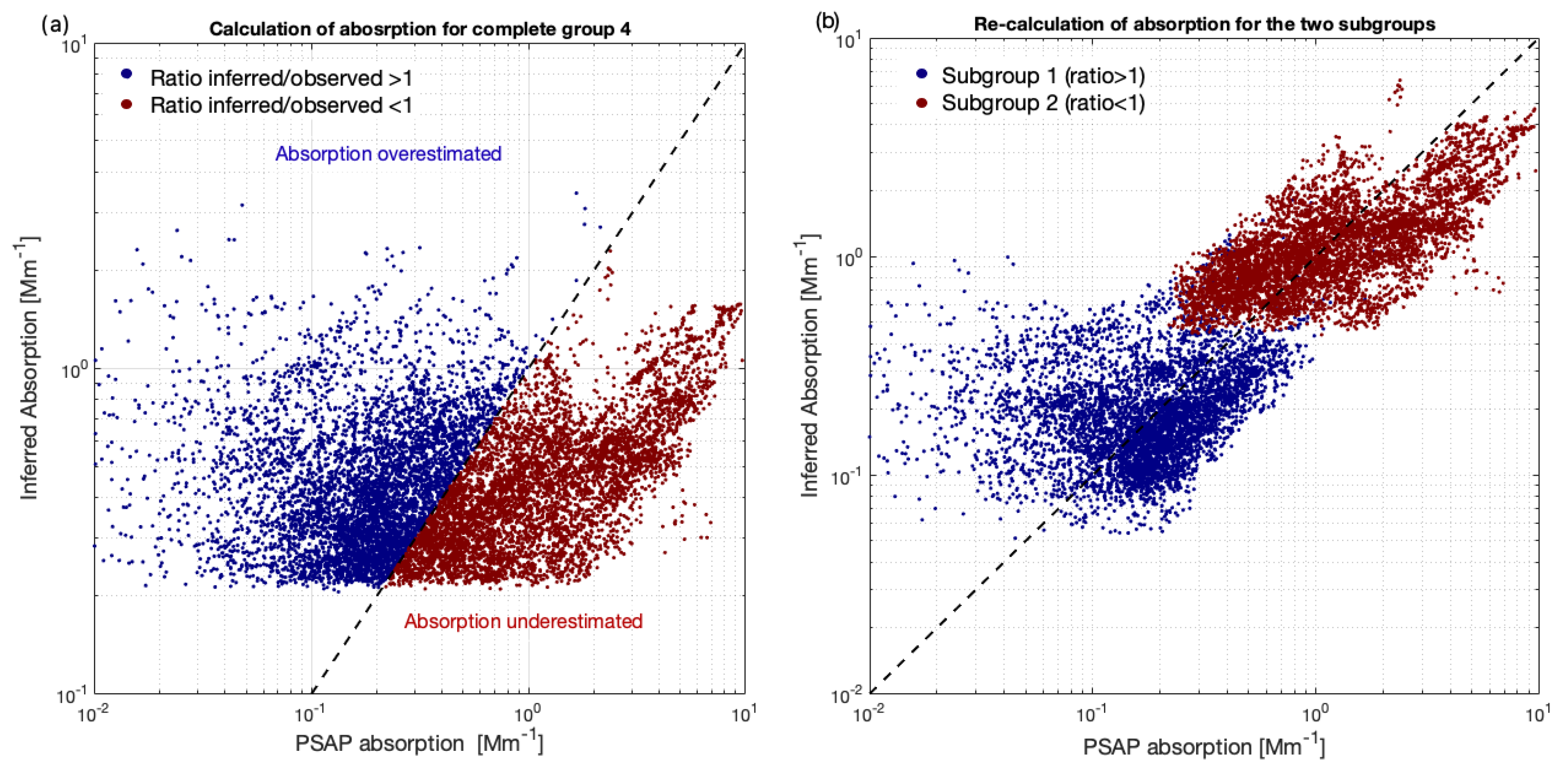



Publisher’s Note: MDPI stays neutral with regard to jurisdictional claims in published maps and institutional affiliations. |
© 2022 by the authors. Licensee MDPI, Basel, Switzerland. This article is an open access article distributed under the terms and conditions of the Creative Commons Attribution (CC BY) license (https://creativecommons.org/licenses/by/4.0/).
Share and Cite
Cremer, R.S.; Tunved, P.; Ström, J. Airmass Analysis of Size-Resolved Black Carbon Particles Observed in the Arctic Based on Cluster Analysis. Atmosphere 2022, 13, 648. https://doi.org/10.3390/atmos13050648
Cremer RS, Tunved P, Ström J. Airmass Analysis of Size-Resolved Black Carbon Particles Observed in the Arctic Based on Cluster Analysis. Atmosphere. 2022; 13(5):648. https://doi.org/10.3390/atmos13050648
Chicago/Turabian StyleCremer, Roxana S., Peter Tunved, and Johan Ström. 2022. "Airmass Analysis of Size-Resolved Black Carbon Particles Observed in the Arctic Based on Cluster Analysis" Atmosphere 13, no. 5: 648. https://doi.org/10.3390/atmos13050648
APA StyleCremer, R. S., Tunved, P., & Ström, J. (2022). Airmass Analysis of Size-Resolved Black Carbon Particles Observed in the Arctic Based on Cluster Analysis. Atmosphere, 13(5), 648. https://doi.org/10.3390/atmos13050648






